Polygonia interrogationis
(Fabricius, 1798)
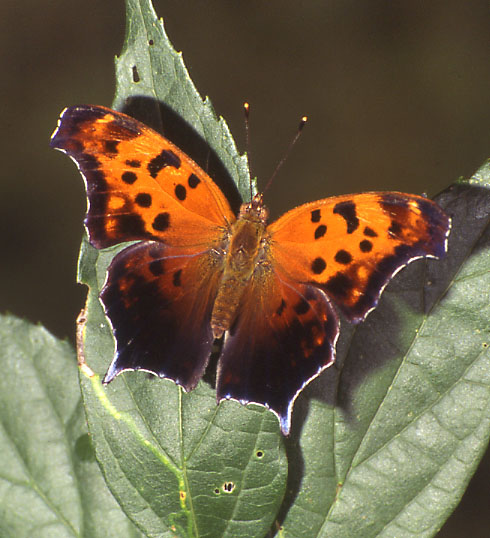
Polygonia interrogationis, Pennsylvania, summer form, courtesy of Leroy Simon.
Superfamily: Papilionoidea Latreille, [1802]
Family: Nymphalidae, Rafinesque, 1815
Subfamily: Nymphalinae, Rafinesque, 1815
Tribe: Nymphalini Rafinesque, 1815
Genus: Polygonia: Hübner, 1819 |
Website designed and maintained
by Bill Oehlke
Box 476, Montague
Prince Edward Island, Canada C0A 1R0
oehlkew@islandtelecom.com
|
Distribution:
The Question Mark Butterfly,
Polygonia interrogationis (wingspan 2.5 - 2.8"),
ranges throughout the entire eastern two-thirds of the
United States and Canada, ranging far to the north (Labrador).
The question mark butterfly is also found in the eastern half of
Mexico.
This species definitely prefers wooded areas and is
frequently seen along roadsides adjacent to woods.
Description:The forewing is hooked and the upperside is
red-orange with black spots. Th upperside of the hindwing of the
summer form is mostly black with a short tail; that of the winter form
has much orange and a longer, violet-tipped tail. The underside is
light brown, and the hindwing has a pearly white question mark in
the center.
The larger size
and purplish-gray wing margins
distinguish this Polygonia species from the smaller
satyrus and comma. Polygonia interrogationis, Florida, summer form, courtesy of
Leroy Simon. |
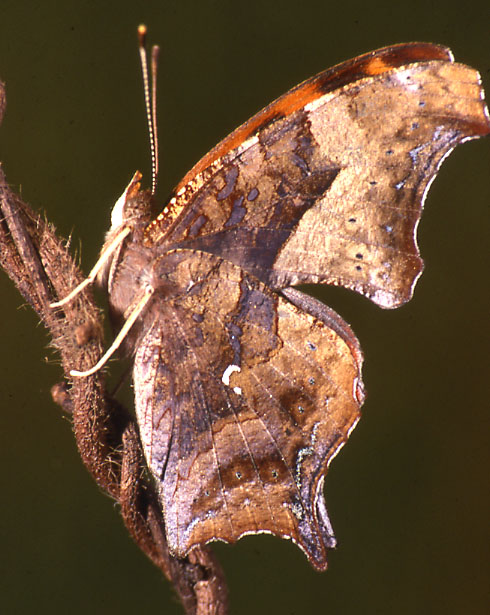
|
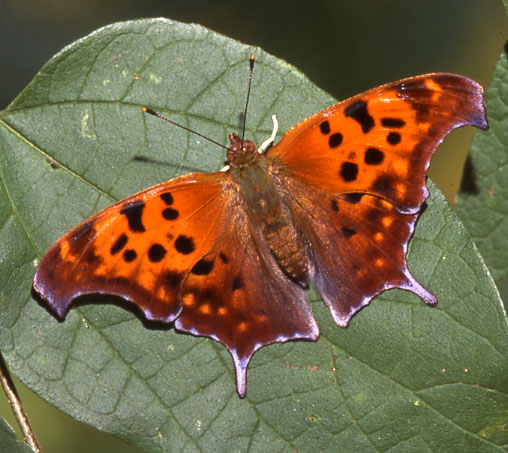
Polygonia interrogationis, Pennsylvania, fall form, courtesy
of Leroy Simon.
Flight time(s) and Adult Food Sources:
The Polygonia interrogationis butterfly hibernates as an
adult in the shelter of wood piles, beneath loose bark, etc., and is
on the wing as soon as the first warm rays of spring sun can
rouse it.
There are two generations in the North with up to four generations
(May to November) in the South.
Adults prefer to feed on rotting fruit, tree sap, dung and carrion.
Only when these are unavailable do Question Marks visit flowers such
as common milkweed, aster, and sweet pepperbush.
Eggs, Larvae, Pupae:
Although elm is the preferred host plant,
Polygonia interrogationis larvae also feed on nettles,
hackberries and hops.
On July 10,
1999, I spotted a female question mark butterfly ovipositing on some tall (4-5 feet) nettles in my side yard.
She was promptly captured and placed in a Remay sleeve over three upright nettle stalks tied
together about 10 inches from the ground.
Bright green, spheroid eggs were deposited singly or in small rows on both
upper and lower leaf surfaces.
The six member egg chain to the right was supsended from the underside of one
nettle leaf. Such chains are not uncommon.
|
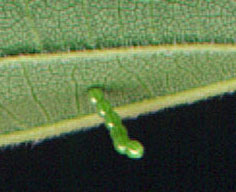 |
Larval Development:
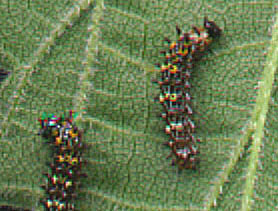
|
Larvae began hatching 4-5 days after egg deposition and commenced feeding
from the underside middle
of foliage.
In additon to several comma females which visited my nettles I also witnessed
ovipositing by a
red admiral and a satyr comma.
|
Clumps of nettles are easily divided in the spring and
cuttings
which I took for an earlier batch of comma satyr larvae resulted in twin stem development from the
notch just below cuttings.
Once caterpillars have moved into
third instar, there is little colour change
in next moults except for a general lightening of body hue.
Larvae increase greatly in
size, however, easily doubling the length of this 3/4 inch third instar caterpillar. |
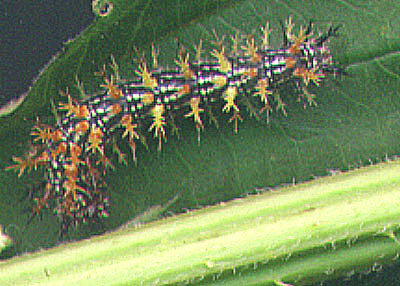 |
Larval development is extremely rapid, especially in the late instars.
Final instar caterpillars have well developed spines to offer some protection from predators.
I frequently
handled larvae gently with my finger tips during food changes and did not find the spines to be urticating; they just look dangerous.
Larvae hang in "j-shape" from a strong silkpad affixed to foliage, stems, or container lids just prior to
the formation of the chrysalids. |
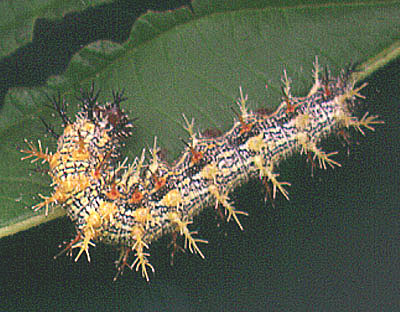 |
These three pupae reveal highly
angularized formation.
Portions of the detached silkpads are visible in lateral and
dorsal views to far left. Such dislodging does not affect subsequent eclosions
as long as the emergent butterflies have a place to climb and hang. |
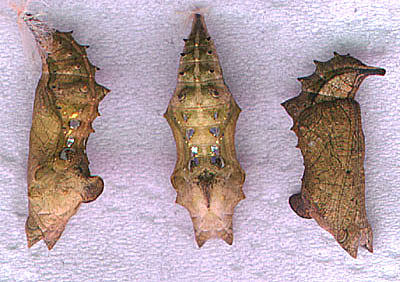 |
I gently scrape silkpads about 1 cm away from cremasters to remove pupae from
their hanging position on the underside of a plastic container lid.
A piece of paper towel on the bottom of a closed brown
paper grocery bag serves as an "emergence cage". These butterflies emerge in approximately nine
days at
room temperature.
Nettles like moist earth. Mine grow in partial shade and serve as larval foodplants for
red admirals, satyr commas
and question marks. Plant some nettles and the butterflies will come.
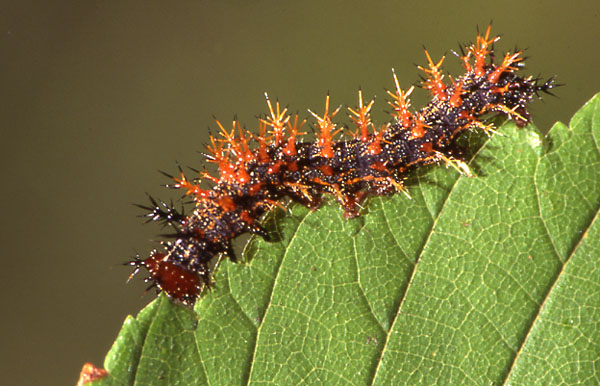
Polygonia interrogationis, courtesy of Leroy Simon.
The scan below was obtained by mounting a dead butterfly in a natural position and then pinning
it to a nettle leaf. I cut off the pin protrusions and then did a scan on my flatbed scanner.
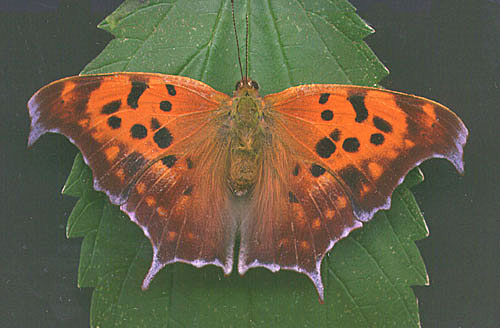
Female Polygonia interrogationis butterfly on nettle
leaf.
ex egg, June 30, ex-pupa July 28, 1999,
Montague, Prince Edward
Island, Canada.
Use your browser "Back" button to returnto the previous page.
|








